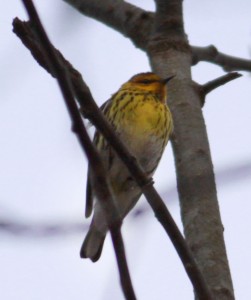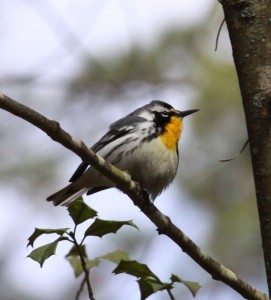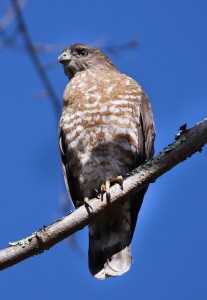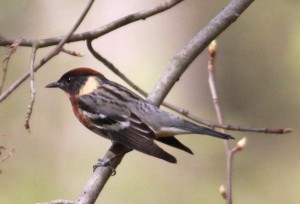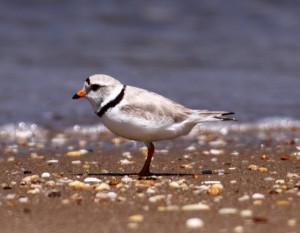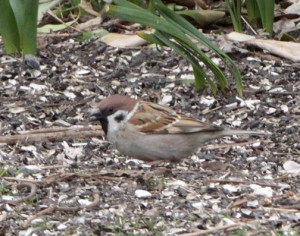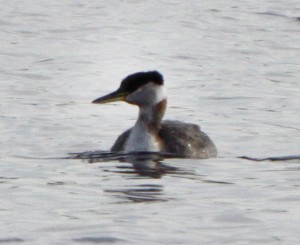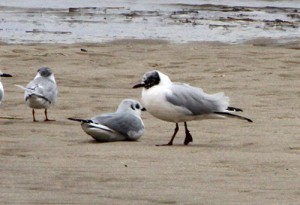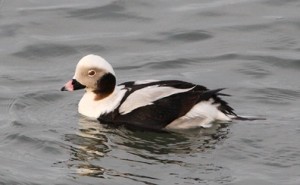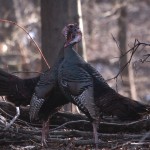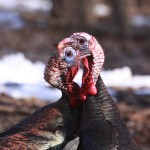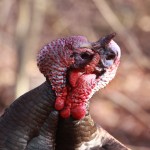At the end of April the birds started migrating through, but that was just a preview of better things that were to come in the birder’s favorite month…May. May 2014 featured a terrific migration. Most of my birding was done in the local patches here in New Jersey. As an example, this month I was able to see two of our tough warbler species (Cape May Warbler and Blackburnian Warbler) right here in my village.
Visits to southern NJ resulted in superb views of multiple Yellow-throated Warblers and the remarkable Prothonotary Warbler.
A highlight of this month was a 4-day trip to the High Point and Stokes State Forest area of northern NJ to scout for a team in preparation for their participation in the World Series of Birding. Eighteen first-of-year birds were spotted on this trip, including Common Raven, Ring-necked Pheasant, nesting Broad-winged Hawks, and Bobolink.
On the way back home I stopped in at the always-reliable Garrett Mountain Reservation for a marvelous afternoon where birds were seemingly everywhere and very tolerant of humans. Wow! Further exploration of Allaire State Park this month yielded some very nice migrants including Bay-breasted and Hooded Warblers and double-digit Scarlet Tanagers.
A series of short morning walks through my village yielded species such as Indigo Bunting, Green Heron, Broad-winged Hawk, Blue-winged Warbler, Wilson’s Warbler, and Northern Waterthrush that I didn’t expect to see in our village. Near the end of the month, after the appearance of new land migrants finally began slowing down, attention turned to the shore area once again, with occasional forays to the beach at Sandy Hook, the marshes of Forsythe, and the Delaware bayshore. Highlights included Red Knots, Piping Plover, Clapper Rail, and Gull-billed Tern. Shorebirds are certain to continue and be a highlight of June.
Here’s my list of new year bird arrivals that I saw this May:
Piping Plover – May 29 – Sandy Hook
Common Tern – May 29 – Sandy Hook
Least Tern – May 29 – Sandy Hook
Mourning Warbler – May 28 – Central Park
Olive-sided Flycatcher – May 28 – Central Park
Gray-cheeked Thrush – May 27 – Frick Park, Pittsburgh
Red Knot – May 18 – Reed’s Beach
Clapper Rail – May 17 – Forsythe NWR
Gull-billed Tern – May 17 – Forsythe NWR
Black Skimmer – May 17 – Forsythe NWR
Seaside Sparrow – May 17 – Forsythe NWR
Black-bellied Whistling-duck – May 17 – Patriot Lake, Galloway, NJ
Grasshopper Sparrow – May 15 – Collier’s Mills WMA
Black-billed Cuckoo – May 15 – Assunpink WMA
Yellow-breasted Chat – May 15 – Assunpink WMA
Blue Grosbeak – May 15 – Assunpink WMA
Willow Flycatcher – May 15 – Allentown Mercer Corporate Park
Least Sandpiper – May 15 – Allentown Mercer Corporate Park
Bay-breasted Warbler – May 12 – Allaire State Park
Wilson’s Warbler – May 11 – Leisure Village West
Swainson’s Thrush – May 8 – Garret Mountain Reservation
Nashville Warbler – May 8 – Garret Mountain Reservation
Blackpoll Warbler – May 8 – Garret Mountain Reservation
Canada Warbler – May 8 – Garret Mountain Reservation
Red-breasted Nuthatch – May 8 – Walpack Valley IBA–Blewett Tract
Sora – May 7 – Wallkill River NWR–Owens Station Rd.
Solitary Sandpiper – May 7 – Wallkill River NWR–Owens Station Rd.
Marsh Wren – May 7 – Wallkill River NWR–Owens Station Rd.
Least Flycatcher – May 7 – High Point State Park
Yellow-throated Vireo – May 7 – High Point State Park
Common Raven – May 7 – High Point State Park
Northern Waterthrush – May 7 – High Point State Park
Cerulean Warbler – May 7 – High Point State Park
Magnolia Warbler – May 7 – High Point State Park
Blackburnian Warbler – May 7 – High Point State Park
Chestnut-sided Warbler – May 7 – High Point State Park
Bobolink – May 7 – Layton Grasslands
Ring-necked Pheasant – May 5 – Sally Harden Rd.–Vesper Hill
Veery – May 5 – Collier’s Mills WMA
Semipalmated Sandpiper – May 4 – Forsythe NWR
Semipalmated Plover – May 4 – Forsythe NWR
Short-billed Dowitcher – May 4 – Forsythe NWR
Willet – May 4 – Forsythe NWR
Spotted Sandpiper – May 4 – Forsythe NWR
Whimbrel – May 4 – Forsythe NWR
Eastern Wood-Pewee – May 4 – Belleplain State Forest
Acadian Flycatcher – May 4 – Belleplain State Forest
Yellow-billed Cuckoo – May 4 – Belleplain State Forest
Prothonotary Warbler – May 4 – Belleplain State Forest
Worm-eating Warbler – May 4 – Belleplain State Forest
Cape May Warbler – May 4 – Manchester
Wood Thrush – May 3 – Allaire State Park
Scarlet Tanager – May 3 – Allaire State Park
Hooded Warbler – May 3 – Allaire State Park
Black-throated Blue Warbler – May 3 – Allaire State Park
Red-eyed Vireo – May 3 – Allaire State Park
Rose-breasted Grosbeak – May 3 – Allaire State Park
Baltimore Oriole – May 3 – Allaire State Park
American Redstart – May 2 – Double Trouble State Park
Indigo Bunting – May 2 – Leisure Village West
Blue-winged Warbler – May 2 – Leisure Village West
Orchard Oriole – May 1 – Whitesbog
Yellow Warbler – May 1 – Whitesbog
Its springtime here in the northeast, and the migrants are coming through and filling the air with song, bringing us to today’s topic. When searching for birds, most beginning birders focus on the ‘watching’ part of birdwatching; looking for bright colors and trying to spot movements that reveal the presence of a bird. That is a very reasonable place to begin, but perhaps the main difference between novice and experienced birders is that skilled birders are much more attuned to finding birds by using their ears. We birders are fortunate that birds often make sounds that reveal their presence, unlike animals like deer, reptiles, butterflies, etc. that typically remain silent to avoid detection. This is incredibly valuable because even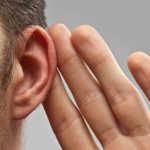 the most colorful birds can be very difficult to find when they are not moving. Bird sounds can range from full-scale songs intended to advertise territory or to attract a mate, to contact calls for communicating with their partners or other members of their flock, to warning calls signaling that danger is near, to begging calls from juveniles to their parents. Many of these sounds are distinct for a particular species and can even be used to distinguish species that are outwardly very similar.
the most colorful birds can be very difficult to find when they are not moving. Bird sounds can range from full-scale songs intended to advertise territory or to attract a mate, to contact calls for communicating with their partners or other members of their flock, to warning calls signaling that danger is near, to begging calls from juveniles to their parents. Many of these sounds are distinct for a particular species and can even be used to distinguish species that are outwardly very similar.
It is intuitive that using the two senses of sight and hearing to finds birds will result in greater success than using only one of them, but it is perhaps not so obvious that birding by ear often is actually more productive than using vision. This is due to the fact that we can hear all around us while our vision is restricted to just a portion of the view in front, so birding by ear enables detection of birds in all directions. Moreover, sounds travel around obstacles, so a bird that is obscured by a leaf or a branch might not be visible, but can still be heard. Thus, under the most difficult viewing conditions, such as when birds are singing from within thick foliage, or from the dense reeds of a marsh, or even at night when we can’t see them at all, they can still be identified if they are vocalizing. As a gauge of its importance, I estimate that when I am birding for spring migrants, perhaps 70% of the birds are located and identified first by sound, and only subsequently by sight. That means that if you are only birding by sight, then you are missing well more than half of the birds in the area.
Assuming that you now are convinced that birding by ear is a useful skill that can bring your birding to a new level, how then do we go about developing that skill? I pass along two suggestions that I found helpful. First of all, birding by ear is a skill that does not just happen because we want it to happen. It is something that we need to develop actively. Although it is theoretically possible to download recordings of bird songs and attempt to memorize them one by one, in practice this is not a realistic goal. Most of us simply do not have the ear to distinguish and memorize hundreds of songs without first learning HOW to do it. Fortunately, instructional series exist that teach the songs of many bird species, and it is well worth the investment to 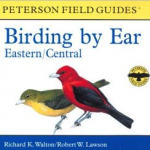 acquire these lessons. I highly recommend the Peterson Field Guides Birding By Ear and More Birding By Ear discs. These lessons teach bird song brilliantly using a few simple techniques. First, the bird songs are placed into logical groups (Warblers with simple songs, Warblers with complex songs, Thrushes, Vireos, Woodpeckers, etc.) that typically consist of four to seven species, thereby simplifying the process. Thus, even if we can’t at first identify the species, at least we can narrow it down to a small group of possibilities. Second, within the groups, the songs are repeated and compared to each other, stimulating the learning process. Finally, the methods used in these lessons train us to listen to the structure of the song, its length, its volume, and its tone. The same methods can be used to analyze the songs of any new species that might be heard. For example, if I travel to a foreign country and hear a song for the first time, I immediately take note of whether the song consists of simple repeated notes or has a more complex structure, whether the song changes in volume or pitch, and whether it has multiple parts. Similar to the way we learn key identification points when birding visually, these lessons teach the audible clues that are diagnostic for common bird species.
acquire these lessons. I highly recommend the Peterson Field Guides Birding By Ear and More Birding By Ear discs. These lessons teach bird song brilliantly using a few simple techniques. First, the bird songs are placed into logical groups (Warblers with simple songs, Warblers with complex songs, Thrushes, Vireos, Woodpeckers, etc.) that typically consist of four to seven species, thereby simplifying the process. Thus, even if we can’t at first identify the species, at least we can narrow it down to a small group of possibilities. Second, within the groups, the songs are repeated and compared to each other, stimulating the learning process. Finally, the methods used in these lessons train us to listen to the structure of the song, its length, its volume, and its tone. The same methods can be used to analyze the songs of any new species that might be heard. For example, if I travel to a foreign country and hear a song for the first time, I immediately take note of whether the song consists of simple repeated notes or has a more complex structure, whether the song changes in volume or pitch, and whether it has multiple parts. Similar to the way we learn key identification points when birding visually, these lessons teach the audible clues that are diagnostic for common bird species.
Learning all the bird songs, however, is only part of the story. A second step is to develop techniques that make it possible to hear and register as many sounds as possible. Of utmost importance, birding ideally should be done quietly to enable hearing weak, high-pitched, or distant sounds. But even moreso, we need to train ourselves to immediately connect that sound with the correct species. I have found it an extremely helpful exercise to walk through the woods, consciously (and quietly) saying the name of each species that I hear. As this process is repeated, I find that it has enabled me to recognize more sounds or deeper layers of sounds than I had recognized previously. It is as if by the act of saying the birds name, your mind actively registers for example that there is a Cardinal on the left and an Ovenbird is ahead and a Black-throated Green Warbler is directly above, and then it starts listening for more. If you hear a sound and can’t say the name of the bird, then it is time to stop and figure it out before moving on, since you will likely meet that species again later in the day. This skill is probably analogous to listening to a complex piece of music, where a casual listener upon first exposure might hear only the most obvious parts of the piece, whereas a trained musician immediately hears the deeper layers created by the strings, horns, vocals, and percussion lines.
Now a few parting thoughts. Don’t expect birding by ear to be a simple process, but do expect it to be very rewarding as your skills improve. Consider it a long-term goal that you will not achieve in a single year. It is not necessary to know every song of every bird. Focus first on the sounds of your local resident species; anticipate what will be the most abundant 10 or 20 species in your area, learn their songs, and then you simply need to listen for new songs when birding, which will result in finding new birds. Don’t be surprised if you will need to refresh your memory of the songs and calls of migrants every year when they come through. Above all, hang in there and enjoy the process. Take joy and satisfaction from the new songs that you have learned rather than becoming frustrated because you don’t yet know them all. It will come with time. It is a great feeling to reach the stage where you can walk through the woods confidently knowing which birds are making those beautiful sounds without even raising your binoculars.
More advice can be found HERE in part 2 of this series, or go back to part 1.
April has brought on the expected change in birds here on the east coast. The only problem is that it has been a chilly spring for the most part, so migration is delayed by a week or more. Ducks essentially all departed by the third week of April, along with the Brown Creepers, Yellow-bellied Sapsuckers, and Golden-crowned Kinglets that we have been enjoying for most of the winter, being replaced by our north-bound migrants from the south. Thus, I’ve been able to see twelve species of warblers so far this year, but most have been in relatively low numbers. Perhaps the most notable of the warbler sightings were two separate times this month that I found Louisiana Waterthrush at Double Trouble State Park, including two individuals on April 28. When I entered these reports into eBird, I found that they were the first reports of that species in eBird for Ocean County ever! They clearly are not common here, and maybe…just maybe…those two will stay and breed here? Stay tuned for updates. Coming in a close second place in my top warbler sightings was the seven Yellow-throated Warblers seen at Atlantic County Park. Great habitat there, and I’ll have to return back again this spring.
White-eyed, Blue-headed, and Warbling vireos started to appear in the last week along with two common resident flycatcher species, Eastern Kingbird and Great Crested Flycatcher. Along the coast, early in the month we spotted our first Snowy Egrets and Glossy Ibis, who were joined in the marshes near the end of the month by Little Blue and Tri-colored Herons and both Yellowlegs. More shorebird species have been reported locally, and I’ll be looking for them in early May.
Perhaps the most remarkable day of the year, however, came on April 16, when a trip to Long Beach Island and Barnegat Lighthouse State Park was nearly spoiled by chilly temperatures, high tides, and 30 mph gusts coming off the ocean. I said ‘nearly spoiled’ because I was able to find Snowy Egrets and a Tri-colored Heron in the marshes of LBI and on the way back from Barnegat jetty I spotted a late Snowy Owl huddling alongside the dunes. That was a super find, but it became even more remarkable when I returned home and noticed a male Ruby-throated Hummingbird visiting my feeders. Snowy Egrets and Snowy Owl and Ruby-throated Hummingbirds on the same day! Wow. That is not a combination I ever expected to see in one day. I can’t wait to see what surprises the next month brings.
In non-birding news, this year I’ve started trying to learn our butterflies and some of the more unique plants of the region. With the chilly temps and windy days butterflies have been scarce, but I’ve been able to identify Cabbage Whites, Blueberry Azures, Mourning Cloaks, and Eastern Comma. The best plant sighting has been the welcome flowering of Golden Club in the freshwater wetlands.
My new birds for April:
Eastern Kingbird – April 28 – Double Trouble State Park
Great Crested Flycatcher – April 28 – Double Trouble State Park
Prothonotary Warbler – April 28 – Leisure Village West
Prairie Warbler – April 27 – Double Trouble State Park
Chimney Swift – April 26 – Lord Sterling Park
Black-throated Green Warbler – April 26 – Great Swamp NWR
Blue-headed Vireo – April 26 – Great Swamp NWR
Warbling Vireo – April 26 – Scherman/Hoffman Sanctuary
Black-capped Chickadee – April 26 – Scherman/Hoffman Sanctuary
House Wren – April 26 – Scherman/Hoffman Sanctuary
Pileated Woodpecker – April 21 – Allaire State Park
Northern Parula – April 17 – Atlantic County Park
Yellow-throated Warbler – April 17 – Atlantic County Park
Ruby-throated Hummingbird – April 16 – Manchester, NJ
White-eyed Vireo – April 16 – Barnegat Lighthouse State Park
Little Blue Heron – April 14 – Cattus Island County Park
Tri-colored Heron – April 14 – Cattus Island County Park
Common Yellowthroat – April 14 – Double Trouble State Park
Black-and-white Warbler – April 13 – Double Trouble State Park
Lesser Yellowlegs – April 12 – Forsythe NWR
Caspian Tern – April 12 – Forsythe NWR
Purple Martin – April 12 – Forsythe NWR
Brown Thrasher – April 12 – Forsythe NWR
Sharp-shinned Hawk – April 9 – Island Beach State Park
Gray Catbird – April 9 – Island Beach State Park
Ruby-crowned Kinglet – April 8 – Central Park
Louisiana Waterthrush – April 8 – Central Park
Black-crowned Night-heron – April 8 – Central Park
Baltimore Oriole – April 8 – Central Park
Barn Swallow – April 7 – Whitesbog
Northern Rough-winged Swallow – April 7 – Whitesbog
Snowy Egret – April 6 – Forsythe
Glossy Ibis – April 6 – Forsythe
Red-headed Woodpecker – April 6 – Dorothy
American Kestrel – April 6 – Lenape Farms
Blue-gray Gnatcatcher – April 6 – Lenape Farms
Palm Warbler – April 5 – Double Trouble
Great Horned Owl – April 2 – Home (hooting at 3 AM)
Chipping Sparrow – April 2 – Cattus Island
Today we say goodbye to March 2014. It was a good month here at Birdquiz.net. Many new quizzes were added and the appearance and organization of the site were greatly improved. But more importantly, the birding was exciting this month. It was a long and snowy winter here in the east, and a remarkable winter for two species that are usually difficult to find: Snowy Owl and Red-necked Grebe. Here in NJ, seeing up to 6 Snowy Owls in a day or Red-necked Grebes at 4 different locations in a week is exceptional, but that’s the kind of month we had. This is a good time of year to get last looks at the ducks before they depart for northward locations, transitioning into their breeding plumage, and welcoming the vanguard of spring migrants. Speaking of migrants, the earliest visitors have begun to arrive, with a few Eastern Phoebes found in the past week or so, Laughing Gulls and Forster’s Terns have appeared along the shore, Greater Yellowlegs and Killdeer are back, Tree Swallows are back gliding over the lakes, and the first Great Egrets have brightened up the marshes. Not only have birds begun arriving, but some are answering nature’s call. Bald Eagle chicks are being fed, Osprey are quickly building nests, Pine Warblers have arrived and begun trilling from the pines, and American Woodcock are performing their spring aerial displays.
Other birding highlights for me from this month include two Black-headed Gulls in Cape May, three Trumpeter Swans at Assunpink Lake, and a single lifer, a rare-for-the-east Eurasian Tree Sparrow that was found in Cape May. I’m looking forward to finding out what surprises April brings my way.
My new March birds:
Blue-winged Teal – 26 Mar – Edwin B. Forsythe NWR–Wildlife Drive
Black-headed Gull – 22 Mar – Cape May
Laughing Gull – 22 Mar – Cape May
Forster’s Tern – 22 Mar – Cape May
Eurasian Tree Sparrow – 22 Mar- Cape May (lifer)
Trumpeter Swan – 21 Mar – Assunpink WMA
Great Egret – 20 Mar – Parker Run Dock St.
Brown-headed Cowbird – 20 Mar – Manahawkin WMA
Osprey – 19 Mar – Double Trouble State Park
Wilson’s Snipe – 19 Mar – Double Trouble State Park
Pine Warbler – 19 Mar – Double Trouble State Park
Wild Turkey – 16 Mar – Leisure Village West
Greater Yellowlegs – 15 Mar – Edwin B. Forsythe NWR–Bridge to Nowhere
Killdeer – 14 Mar – Manasquan Reservoir IBA
Eastern Phoebe – 12 – Whitesbog
Green-winged Teal – 12 Mar – Whitesbog
Fish Crow – 08 Mar – Leisure Village West
American Woodcock – 01 Mar – Leisure Village West
Here we present part 2 of our continuing series on advice for beginning or novice birders, with two more suggestions.
Go out with birding groups. Is it better to go out birding alone or with a group? The answer is that there are distinct advantages to birding alone (or with a friend) compared to birding with a group. Birding alone has the advantages of moving at your own pace, going wherever you want, and spending as much time observing any single bird as you like. All of these are great. But also realize that birding with a group has several advantages, especially if you are not very experienced. First, the local birding groups will be visiting the locations that will be most productive at that time of year, and taking a route that will optimize finding birds in that location. This is especially valuable when birding larger parks or locales. It is worthwhile joining with these groups to learn the ‘standard’ routes that you can then explore on your own later. Second, the group leaders will have historical knowledge of those locations. It is very beneficial to know that a specific part of a park or a preserve might be a historical hotspot for an interesting species. You will learn things like ‘this field is normally very good for bluebirds’ or ‘we have found woodcock at this location for the past five years’ that would otherwise be difficult to learn by yourself. Third, when birding with a group there are many pairs of eyes looking for birds, so the group typically will find more birds than any single birder. You are bound to benefit from having extras pairs of eyes and ears scanning in all directions. Fourth, beginners who go out with groups can learn good birding habits, by watching the leader or the experienced birders in the group. Watch what they do and what they don’t do, and then emulate those same good habits when you are birding by yourself. Note how quietly and slowly they proceed, how they are listening for bird sounds, and what types of habitat they spend the most time in. These good habits are not easy to learn from books or field guides. Finally, by joining occasionally with groups you can meet other birders with similar levels of expertise that you might be comfortable birding with together later outside of the larger group. The only real disadvantage of group birding is that popular walks can become large, resulting in too much disruptive noise, but this negative aspect of group birding is balanced by the many advantages of joining a group.
Keep records. Many birders keep lists; lists of life birds, lists of year birds, lists of county birds, lists of yard birds, and more. I once met a photographer who told me that he kept a list of how many bird species he photographed with that specific camera. I am not an advocate of extensive listing, because eventually it seems to become almost pathological, when the goal of adding a species to a list becomes more important than actually enjoying the bird itself. I will, however, advocate more general record keeping and describe its advantages. Keep track of the birds that you see and their relative abundance after returning from a field trip. Record keeping such as this will allow you to notice the ebb and flow of birds through your area; when do the shorebirds or warblers arrive in your area during spring, when do they leave during the fall, and do they arrive and leave all at once or do subsets arrive and leave before others? After keeping records such as this for a year or two you will then be able to anticipate the arrival of new species and their departure, thereby becoming familiar with the rhythms of the year. If you can equate bird arrivals and departures not just with the calendar year, but with other natural events such as the appearance of specific flowers or fruits or insects or butterflies, you will then be able to link bird movements in with the bigger picture of natural events.
So how should record keeping be done? One way is to use a typical old-school handwritten version with field notes and drawings. This approach has a romanticism about it, but lacks some of the benefits of electronic versions. The major advantage of electronic record-keeping is that it allows searches for specific birds or locations or dates that are not possible with pen-and-paper methods. For example, I often like to search through old records for a single species, such as when and where did I see Pileated Woodpecker. Or if I’m wondering when to put out the hummingbird feeders, I can search for their typical arrival dates each year. Or when did I observe the peak migration of Broad-winged Hawks at the hawk watch? Although record keeping can be done using any electronic database, I have become hooked into using eBird (ebird.org). We will learn more about eBird in a later post, but for now we will simply note that eBird has the advantage of very easy data entry without extensive typing, the ability to include photos or comments, and the sightings become part of the larger eBird database, contributing to ‘citizen science’. As a side benefit, eBird will automatically generate updated life lists, year lists, state lists, etc. Regardless of whether you keep track of your sightings through eBird or a different electronic database, you will benefit from keeping records and the ability to search through your previous field sightings.
More advice can be found HERE in part 3 of this series, or go back to part 1.
OK, so now you’ve decided that you’d like to become a birder. Maybe a friend or someone in your family is trying to get you interested. Maybe you’ve just seen an interesting colorful bird and now want to find more. Maybe you are now retired and have time to pursue new interests. Regardless of how or why you begin with this hobby, birding can be overwhelming as a beginner and it can be intimidating to ask for help from some of the experts who are around. If this sounds familiar, I will be compiling a series of recommendations here to help you on your way. We’ll start this series with three tidbits of advice.
1. Hang in there. Probably the best place to start is by saying that if it becomes difficult in the beginning that you shouldn’t give up. Birding is a great hobby that will provide rewards for years and years and years to come. As your birding experience grows, the common birds eventually will become easy to identify, but a new group of challenge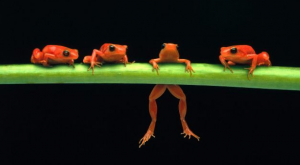 s, including rarer birds, birds in different plumages, birds in different locations, and learning bird songs will continually arise and present new challenges and new opportunities to learn. Yes, it can be tough in the beginning when it feels like you don’t know anything, but turn the difficulties into a positive. For example, as an experienced birder who has seen more than 1,200 species, it is tough for me to find new birds locally, but I am often envious when I am with new birders who are seeing a few new species every day. Enjoy the thrill and all the new things you are learning during your earliest birding adventures.
s, including rarer birds, birds in different plumages, birds in different locations, and learning bird songs will continually arise and present new challenges and new opportunities to learn. Yes, it can be tough in the beginning when it feels like you don’t know anything, but turn the difficulties into a positive. For example, as an experienced birder who has seen more than 1,200 species, it is tough for me to find new birds locally, but I am often envious when I am with new birders who are seeing a few new species every day. Enjoy the thrill and all the new things you are learning during your earliest birding adventures.
2. Get decent optics. One of the advantages of birding is that it doesn’t have to be an expensive hobby. At a simple level, the essential equipment that a beginning birder needs is a pair of binoculars and a field guide. That’s it. As your interest in the hobby grows, you will find yourself buying more equipment: a spotting scope, specialized identificati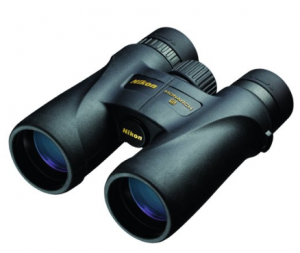 on guides, photographic equipment, birding apps, etc. But don’t worry about them now. Let’s start at the beginning: what binoculars to get? The range of cost and quality is quite broad, with top-of-the-line binoculars costing over $2,600! If you are a Wall St. executive and cost is not a concern, feel free to start there. But for the rest of us that is not a realistic starting point. On the other hand, using a clunky old pair of hand-me-down binoculars that belonged to your grandparents or buying the cheapest binoculars on the market now will only result in frustration and difficulty in finding birds. Fortunately, excellent binoculars can be obtained for ~$250 that will last for many years. The most popular model in this range is the Nikon Monarch5 8×42 binoculars, currently available for $247. I used a pair of similar Monarchs for more than 10 years and still have them as my backup pair. Monarchs are probably the most common binoculars seen on group birding walks; the optics are terrific, they are waterproof and fogproof, can focus to within 8 feet, and Nikon provides a lifetime warranty. After you’ve been birding for 10 or more years you might want to upgrade, but as a beginner, the Nikon Monarchs or similar quality binoculars is a great place to start. The only caveat to this recommendation is that no pair of binoculars will be perfect for every person; if you wear eyeglasses or if your eyes are closer together or further apart than most people, then test them yourself before buying to ensure that they ‘feel’ right to you. It is well worth the investment to avoid the frustration caused by poor optics.
on guides, photographic equipment, birding apps, etc. But don’t worry about them now. Let’s start at the beginning: what binoculars to get? The range of cost and quality is quite broad, with top-of-the-line binoculars costing over $2,600! If you are a Wall St. executive and cost is not a concern, feel free to start there. But for the rest of us that is not a realistic starting point. On the other hand, using a clunky old pair of hand-me-down binoculars that belonged to your grandparents or buying the cheapest binoculars on the market now will only result in frustration and difficulty in finding birds. Fortunately, excellent binoculars can be obtained for ~$250 that will last for many years. The most popular model in this range is the Nikon Monarch5 8×42 binoculars, currently available for $247. I used a pair of similar Monarchs for more than 10 years and still have them as my backup pair. Monarchs are probably the most common binoculars seen on group birding walks; the optics are terrific, they are waterproof and fogproof, can focus to within 8 feet, and Nikon provides a lifetime warranty. After you’ve been birding for 10 or more years you might want to upgrade, but as a beginner, the Nikon Monarchs or similar quality binoculars is a great place to start. The only caveat to this recommendation is that no pair of binoculars will be perfect for every person; if you wear eyeglasses or if your eyes are closer together or further apart than most people, then test them yourself before buying to ensure that they ‘feel’ right to you. It is well worth the investment to avoid the frustration caused by poor optics.
3. Birding books. There is an entire industry of birding books out there, enough to keep even the most refined expert birders occupied. But which of those books is appropriate or necessary for a beginning birder? For me the best field guide for a beginner is the Peterson Field Guide to the Birds of Eastern and Central North America (or Western North America if that is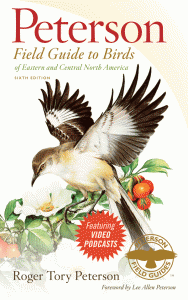 where you live). The Peterson’s Guide, which first was published in 1934 and is now in its 6th edition, was the first modern field guide for birders and to me still remains the best guide for beginners. It focuses on the more common birds, the illustrations are large, with arrows that point to the essential field marks that we should be looking for. Maps are provided in the back showing the geographic distribution of each species. The Peterson’s Guide also comes in a large-format edition and they now offer a Peterson’s “First Guide” that includes only the 180 most common birds in North America, if those are your preferences. Another excellent option is the Sibley Field Guide to Birds of Eastern North America (or Western North America if that is where you live). To me, the Sibley Guide is actually a better field guide, but it seems targeted for more advanced birders. Like the Peterson’s Guide, Sibley also has wonderful illustrations with arrows to point out the essential field marks. There are more illustrations in Sibley, including juvenile and female plumages, and birds in flight, but by necessity the illustrations are smaller than in Peterson. Sibley also includes more rarities that can appear in your area, but since those birds are unlikely to found by beginners, they can be a distraction. One advantage to Sibley is that the range maps are placed alongside the illustration, not in the back of the book, making it easier to know if that bird is likely to be seen in your area. Maybe it is just a matter of taste; these are both excellent and influential field guides, but I think Peterson’s is better for beginners, while Sibley is better for advanced birders. Whichever book you buy, don’t leave it in your car or at home for future reference, but instead bring it with you into the field and use it thoroughly, on the spot. When you find a new bird and read the accompanying commentary immediately, you will learn more, because the guide will point out secondary identification points to look for that you might have missed, occasionally behaviors will be described, potentially confusing species might be mentioned, or the illustrations might help you to find females or immature birds in the area. If you only look that information up after you get home or to your car, it will be too late.
where you live). The Peterson’s Guide, which first was published in 1934 and is now in its 6th edition, was the first modern field guide for birders and to me still remains the best guide for beginners. It focuses on the more common birds, the illustrations are large, with arrows that point to the essential field marks that we should be looking for. Maps are provided in the back showing the geographic distribution of each species. The Peterson’s Guide also comes in a large-format edition and they now offer a Peterson’s “First Guide” that includes only the 180 most common birds in North America, if those are your preferences. Another excellent option is the Sibley Field Guide to Birds of Eastern North America (or Western North America if that is where you live). To me, the Sibley Guide is actually a better field guide, but it seems targeted for more advanced birders. Like the Peterson’s Guide, Sibley also has wonderful illustrations with arrows to point out the essential field marks. There are more illustrations in Sibley, including juvenile and female plumages, and birds in flight, but by necessity the illustrations are smaller than in Peterson. Sibley also includes more rarities that can appear in your area, but since those birds are unlikely to found by beginners, they can be a distraction. One advantage to Sibley is that the range maps are placed alongside the illustration, not in the back of the book, making it easier to know if that bird is likely to be seen in your area. Maybe it is just a matter of taste; these are both excellent and influential field guides, but I think Peterson’s is better for beginners, while Sibley is better for advanced birders. Whichever book you buy, don’t leave it in your car or at home for future reference, but instead bring it with you into the field and use it thoroughly, on the spot. When you find a new bird and read the accompanying commentary immediately, you will learn more, because the guide will point out secondary identification points to look for that you might have missed, occasionally behaviors will be described, potentially confusing species might be mentioned, or the illustrations might help you to find females or immature birds in the area. If you only look that information up after you get home or to your car, it will be too late.
More advice can be found HERE in part 2 of this series.
After a far-too-long hiatus due to lifestyle changes (good-bye old job, hello new home!) and the need to overcome technical difficulties (after all, I’m a birder, not a programmer), I’m thrilled to report that new quizzes are on the assembly line. I’m planning many quizzes using the new slideshow format, and the first of these quizzes, which covers the ducks and geese of North America, can be found here. It appears that the major bugs in the system have been worked out, but if you have technical problems viewing or using the quizzes, please drop me a line at greg at birdquiz.net. Enjoy.
Sometimes you can have a great day of birding without seeing many birds. Today was one of those days, but the story actually began yesterday. I was at the NY Botanical Garden, ending a good day by finding a Winter wren. Two guys came up the trail, saw me and the bird and asked in a foreign accent if it was a Carolina. I explained, and then we started talking. Turns out they are two Danish guys…Kel and Christopher… stopping over in NY for a few days on their way to a birding vacation in Trinidad and Tobago. They will be in NY for one more day and asked for advice on where to go. I suggest Croton Point Park, which they can reach by train. And if they are interested, I can meet them there and show them the park. So that’s what I did today…spend a day birding with two complete strangers from Denmark who I had only known for about five minutes, and I had a blast. Except for the species that they already saw in NYC, everything was new to them, and they were still enjoying the species that they saw over the past few days. I had a few targets in mind for them, and miraculously the birds cooperated, with these guys seeing their first four bald eagles within 5 minutes of leaving the Croton train station and high fives passed all around. At one point I promised them that the next new birds we see would be Red-breasted nuthatches (what was I thinking?), and of course that’s what happened. As they were taking photos of the nuthatches I called them over and pointed out a Barred Owl perched in plain sight (we looked for it in that same area earlier in the day but came up empty), at which point they nearly lost control. Having eventually run out of new species likely for them to see, I asked if they ever saw a Killdeer. The answer was no, and it turns out that for Kel that was a species that he really wanted. I took them to the baseball field, and there were 4 Killdeer. I never saw anybody so happy at finding one of our common species, and they immediately annointed me as master birding guide. I don’t know who had more fun…these guys seeing new birds, or me getting the opportunity to show them. Either way, it’s hard to think of a birding day that I enjoyed more. So thanks to Kel and Christopher.
Wild turkeys were feeling their oats this weekend, putting on quite a show. The colors on the faces of the toms were brilliant and explosive, as if to pronounce their dominance by simply having more color than their challengers. Even moreso, two of the males decided to battle it out, first by pushing each other around the underbrush, with their necks aligned side-by-side. Eventually they raised the battle to a new level by locking jaws and continuing to push each other around. Eventually others in the flock joined the melee, inadvertantly disjoining the original two combatants, which helped to restore order. It was quite sight to witness. Here are some photos of the battle:
